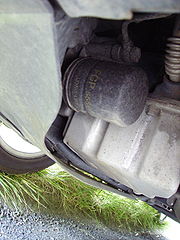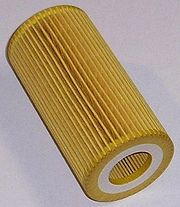
Filter (oil)
Encyclopedia

Filtration
Filtration is commonly the mechanical or physical operation which is used for the separation of solids from fluids by interposing a medium through which only the fluid can pass...
designed to remove contaminants from engine oil, transmission oil
Automatic Transmission Fluid
Automatic transmission fluid is the fluid used in vehicles with self shifting or automatic transmissions. It is typically colored red or green to distinguish it from motor oil and other fluids in the vehicle...
, lubricating oil, or hydraulic oil
Hydraulic fluid
Hydraulic fluids, also called hydraulic liquids, are the medium by which power is transferred in hydraulic machinery. Common hydraulic fluids are based on mineral oil or water...
. Oil filters are used in many different types of hydraulic machinery
Hydraulic machinery
Hydraulic machines are machinery and tools that use liquid fluid power to do simple work. Heavy equipment is a common example.In this type of machine, hydraulic fluid is transmitted throughout the machine to various hydraulic motors and hydraulic cylinders and which becomes pressurised according to...
. A chief use of the oil filter is in internal-combustion engines in on- and off-road motor vehicles
Automobile
An automobile, autocar, motor car or car is a wheeled motor vehicle used for transporting passengers, which also carries its own engine or motor...
, light aircraft
Aircraft
An aircraft is a vehicle that is able to fly by gaining support from the air, or, in general, the atmosphere of a planet. An aircraft counters the force of gravity by using either static lift or by using the dynamic lift of an airfoil, or in a few cases the downward thrust from jet engines.Although...
, and various naval vessels. Other vehicle hydraulic systems, such as those in automatic transmission
Automatic transmission
An automatic transmission is one type of motor vehicle transmission that can automatically change gear ratios as the vehicle moves, freeing the driver from having to shift gears manually...
s and power steering
Power steering
Power steering helps drivers steer vehicles by augmenting steering effort of the steering wheel.Hydraulic or electric actuators add controlled energy to the steering mechanism, so the driver needs to provide only modest effort regardless of conditions. Power steering helps considerably when a...
, are often equipped with an oil filter. Gas turbine
Gas turbine
A gas turbine, also called a combustion turbine, is a type of internal combustion engine. It has an upstream rotating compressor coupled to a downstream turbine, and a combustion chamber in-between....
engines, such as those on jet aircraft, require the use of oil filters. Aside from these uses, oil production, transport, and recycling facilities also employ filters in the manufacturing process.
Bypass and full-flow
Early automobile engines did not use oil filters. For this reason, along with the generally low quality of oil available, very frequent oil changes were required. The first oil filters were simple, generally consisting of a screenSieve
A sieve, or sifter, separates wanted elements from unwanted material using a woven screen such as a mesh or net. However, in cooking, especially with flour, a sifter is used to aerate the substance, among other things. A strainer is a type of sieve typically used to separate a solid from a liquid...
placed at the oil pump
Oil pump (internal combustion engine)
The oil pump in an internal combustion engine circulates engine oil under pressure to the rotating bearings, the sliding pistons and the camshaft of the engine...
intake. In 1923, American inventors Ernest Sweetland and George H. Greenhalgh devised an automotive oil filter and called it the Purolator, a portmanteau of "pure oil later". This was a bypass filter: most of the oil flowed directly from the oil pan to the engine's working parts, and a smaller proportion of the oil was sent through the filter via a second flow path in parallel with the first. The oil was thus filtered over time. Modern bypass oil filter systems for diesel engines are becoming popular in consumer applications, but have been in commercial use for some time due to potential reduction in maintenance costs.
Valves
Most pressurized lubrication systems incorporate an overpressure relief valve to allow oil to bypass the filter if its flow restriction is excessive, to protect the engine from oil starvation. Filter bypass may occur if the filter is clogged or the oil is thickened by cold weather. The overpressure relief valve is frequently incorporated into the oil filter. Filters mounted such that oil tends to drain from them usually incorporatean anti-drainback valve to hold oil in the filter after the engine (or other lubrication system) is shut down. This is done to avoid a delay in oil pressure buildup once the system is restarted; without an anti-drainback valve, pressurized oil would have to fill the filter before travelling onward to the engine's working parts. This situation can cause premature wear of moving parts due to initial lack of oil.
Mechanical
Mechanical designs employ an element made of bulk material (such as cotton waste) or pleated Filter paperFilter paper
Filter paper is a semi-permeable paper barrier placed perpendicular to a liquid or air flow. It is used to separate fine solids from liquids or air.-Properties:Filter paper comes in various porosities and grades depending on the applications it is meant for...
to entrap and sequester suspended contaminants. As material builds up on (or in) the filtration medium, oil flow is progressively restricted. This requires periodic replacement of the filter element (or the entire filter, if the element is not separately replaceable).
Cartridge and spin-on

Magnetic
Magnetic filters use a permanent magnetMagnet
A magnet is a material or object that produces a magnetic field. This magnetic field is invisible but is responsible for the most notable property of a magnet: a force that pulls on other ferromagnetic materials, such as iron, and attracts or repels other magnets.A permanent magnet is an object...
or an electromagnet
Electromagnet
An electromagnet is a type of magnet in which the magnetic field is produced by the flow of electric current. The magnetic field disappears when the current is turned off...
to capture ferromagnetic particles. An advantage of magnetic filtration is that maintaining the filter simply requires cleaning the particles from the surface of the magnet. Automatic transmission
Automatic transmission
An automatic transmission is one type of motor vehicle transmission that can automatically change gear ratios as the vehicle moves, freeing the driver from having to shift gears manually...
s in vehicles frequently have a magnet in the fluid pan to sequester magnetic particles and prolong the life of the media-type fluid filter. Some companies are manufacturing magnets that attach to the outside of an oil filter or magnetic drain plugs -- first invented and offered for cars and motorcycles in the mid-1930s -- to aid in capturing these metallic particles, though there is ongoing debate as to the effectiveness of such devices.
Sedimentation
A sedimentation or gravity bed filter allows contaminants heavier than oil to settle to the bottom of a container under the influence of gravity.Centrifugal
A centrifugal oil cleaner is a rotary sedimentation device using centrifugal forceCentrifugal force
Centrifugal force can generally be any force directed outward relative to some origin. More particularly, in classical mechanics, the centrifugal force is an outward force which arises when describing the motion of objects in a rotating reference frame...
rather than gravity to separate contaminants from the oil, in the same manner as any other centrifuge
Centrifuge
A centrifuge is a piece of equipment, generally driven by an electric motor , that puts an object in rotation around a fixed axis, applying a force perpendicular to the axis...
. Pressurized oil enters the center of the housing and passes into a drum rotor free to spin on a bearing
Bearing (mechanical)
A bearing is a device to allow constrained relative motion between two or more parts, typically rotation or linear movement. Bearings may be classified broadly according to the motions they allow and according to their principle of operation as well as by the directions of applied loads they can...
and seal
Seal (mechanical)
A mechanical seal is a device which helps join systems or mechanisms together by preventing leakage , containing pressure, or excluding contamination...
. The rotor has two jet nozzle
Nozzle
A nozzle is a device designed to control the direction or characteristics of a fluid flow as it exits an enclosed chamber or pipe via an orifice....
s arranged to direct a stream of oil at the inner housing to rotate the drum. The oil then slides to the bottom of the housing wall, leaving particulate oil contaminants stuck to the housing walls. The housing must periodically be cleaned, or the particles will accumulate to such a thickness as to stop the drum rotating. In this condition, unfiltered oil will be recirculated.
High efficiency (HE)
High efficiency oil filters are a type of bypass filter that are claimed to allow extended oil drain intervals. HE oil filters typically have pore sizes of 3 micrometreMicrometre
A micrometer , is by definition 1×10-6 of a meter .In plain English, it means one-millionth of a meter . Its unit symbol in the International System of Units is μm...
s, which studies have shown reduce engine wear. Some fleets have been able to increase their drain intervals up to 5-10 times.

